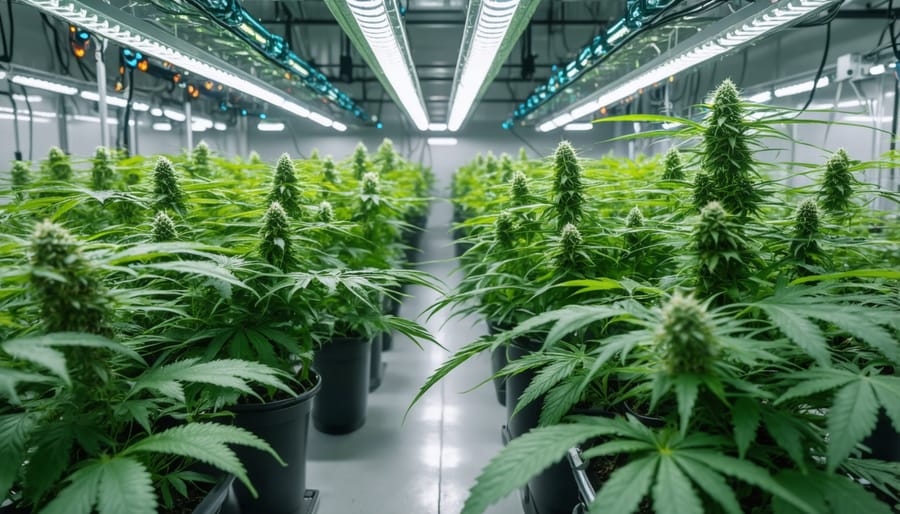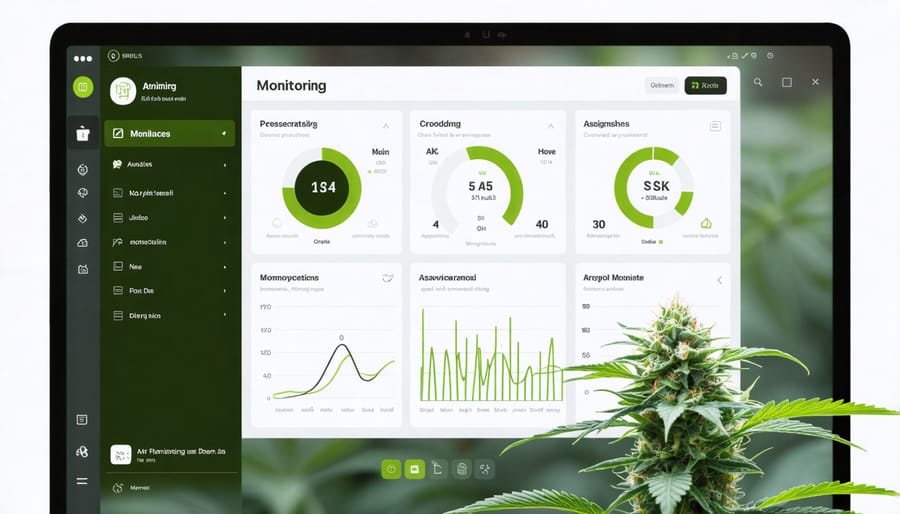The cannabis industry stands at a pivotal crossroads in 2024, experiencing unprecedented growth and transformation that dwarfs previous industry trends. With global market projections exceeding $70 billion by 2028, innovative products like Budpop vapes are reshaping consumer preferences while technological advancements revolutionize cultivation and distribution methods. This seismic shift isn’t merely about market expansion—it represents a fundamental evolution in how cannabis businesses operate, innovate, and scale.
Recent data from industry analysts reveals three transformative forces currently driving the market: artificial intelligence optimization in cultivation, sustainable packaging innovations, and the emergence of personalized cannabis experiences through advanced biotechnology. These developments coincide with sweeping regulatory changes across North America, creating unprecedented opportunities for established players and entrepreneurs alike.
As traditional retail models merge with e-commerce solutions and compliance technology becomes increasingly sophisticated, industry leaders are positioning themselves at the intersection of innovation and regulation. This comprehensive analysis explores the most significant trends shaping the cannabis landscape, offering actionable insights for stakeholders navigating this dynamic market.
Emerging Consumer Preferences Driving Market Evolution
Premium Products and Craft Cannabis
The cannabis market is experiencing a significant shift toward premium and craft products, mirroring the artisanal movement seen in industries like craft beer and specialty coffee. Market data shows that consumers are increasingly willing to pay more for cannabis products that offer superior quality, unique characteristics, and sustainable production methods.
Craft cannabis producers are distinguishing themselves through small-batch cultivation, hand-trimming, and meticulous attention to terpene profiles. These artisanal approaches result in products with enhanced flavor profiles, higher potency, and distinctive effects that appeal to discerning consumers. Industry experts note that craft producers typically maintain stricter quality control standards and often employ organic growing practices.
The premium segment has expanded beyond traditional flower products to include high-end concentrates, edibles, and wellness products. Luxury packaging, detailed strain information, and transparent cultivation practices have become key differentiators in this market. Data from leading dispensaries indicates that premium products now account for approximately 30% of total sales, with year-over-year growth outpacing standard offerings.
Consumer education plays a crucial role in this trend, as buyers become more knowledgeable about cultivation methods, strain genetics, and the importance of proper curing processes. This increased awareness has created a sophisticated customer base that values product origin, growing conditions, and the expertise behind their cannabis purchases, similar to wine connoisseurs seeking specific vintages and terroirs.
Health-Conscious Cannabis Consumption
The cannabis industry is experiencing a significant shift towards health and wellness-focused products, driven by consumers who are increasingly conscious about their overall well-being. This trend has led to the development of precisely dosed edible cannabis products and microdosing options that allow users to maintain better control over their consumption.
Recent market research indicates that 64% of cannabis consumers are actively seeking products with specific wellness benefits, such as sleep enhancement, stress reduction, and pain management. This has spurred innovation in product formulations, with manufacturers developing specialized blends that combine cannabinoids with other natural wellness ingredients like adaptogens and essential oils.
Low-THC and CBD-dominant products have gained particular traction among health-conscious consumers. Dr. Sarah Chen, a cannabis researcher at the University of British Columbia, notes, “We’re seeing a growing demographic of users who want the therapeutic benefits of cannabis without significant psychoactive effects.”
The wellness trend has also influenced consumption methods, with vaporization and sublingual applications becoming increasingly popular due to their precise dosing capabilities and reduced respiratory impact compared to traditional smoking. Additionally, organic cultivation practices and clean extraction methods have become key selling points for brands targeting health-conscious consumers.
Technology and Innovation Transforming Operations
AI-Driven Cultivation Solutions
Artificial intelligence is revolutionizing cannabis cultivation by introducing unprecedented levels of precision and efficiency. Leading cultivators are implementing AI-powered systems that continuously monitor and adjust growing conditions, resulting in consistently higher yields and improved product quality. These smart systems analyze thousands of data points, from humidity levels to plant health indicators, making real-time adjustments that would be impossible to manage manually.
Dr. Sarah Chen, a cultivation technology expert at GreenTech Solutions, notes that “AI-driven cultivation has reduced resource consumption by up to 25% while increasing yield quality by 18% in controlled studies.” These systems are particularly effective at identifying potential issues before they become problematic, using computer vision and machine learning to detect early signs of pest infestations or nutrient deficiencies.
Major innovations include automated trimming systems guided by AI, which can process plants with greater precision than human workers, and predictive analytics that help growers optimize harvest timing. Some facilities are now implementing AI-powered climate control systems that learn from historical data to create ideal growing conditions for specific cannabis strains.
Despite the initial investment costs, many cultivators report that AI systems pay for themselves within 18-24 months through reduced labor costs, improved resource efficiency, and higher-quality yields. As technology continues to advance, experts predict that AI will become standard equipment in commercial cannabis operations, driving the industry toward more sustainable and profitable cultivation practices.


Digital Retail Solutions
The cannabis retail landscape is undergoing a dramatic digital transformation, with e-commerce solutions and innovative payment systems leading the way. Recent data from cannabis analytics firm Headset shows that online ordering now accounts for approximately 25% of all legal cannabis sales in North America, marking a significant shift in consumer purchasing behavior.
Mobile applications and digital menus have become essential tools for dispensaries, allowing customers to browse products, check real-time inventory, and place orders for pickup or delivery where legally permitted. Major cannabis retailers are investing heavily in user-friendly interfaces that provide detailed product information, customer reviews, and personalized recommendations based on previous purchases.
Payment solutions are evolving to address the industry’s unique challenges. While federal restrictions still limit traditional banking options, new fintech solutions are emerging. Digital payment platforms specifically designed for cannabis transactions are gaining traction, offering compliant alternatives to cash payments. These systems integrate seamlessly with point-of-sale systems and provide enhanced security features.
Dispensaries are also leveraging artificial intelligence and data analytics to optimize inventory management and enhance customer experience. Machine learning algorithms analyze purchase patterns to predict demand, while CRM systems help maintain customer relationships through targeted marketing campaigns and loyalty programs.
As regulations continue to evolve, these digital solutions are becoming increasingly sophisticated, offering features like age verification, purchase limit tracking, and compliance reporting to ensure adherence to local and state regulations.
Regulatory Landscape and Market Access
Interstate Commerce Possibilities
The possibility of interstate commerce in the cannabis industry represents a potential watershed moment for the North American market. As federal legalization discussions continue to evolve, industry experts anticipate significant changes in how cannabis products move across state lines. Currently, individual state markets operate as isolated entities, leading to inefficiencies and higher costs for both producers and consumers.
Recent legislative proposals and industry advocacy efforts have begun laying the groundwork for cross-state trading frameworks. States like Oregon and California, dealing with oversupply issues, could particularly benefit from the ability to export their products to markets with limited production capacity. However, these developments face regulatory challenges in extracts and other product categories that would need standardization across jurisdictions.
Economic projections suggest that interstate commerce could create a $30 billion market opportunity by 2025. This would enable more efficient supply chains, reduce production costs, and potentially lead to price stabilization across regions. Industry analysts also predict that interstate trade would accelerate industry consolidation, with larger operators leveraging economies of scale to establish dominant market positions.
For smaller producers, preparation for this eventual shift might include focusing on unique product offerings, building strong regional brands, and developing relationships with potential distribution partners in other states. The key to success will lie in balancing competitive advantages while navigating evolving regulatory frameworks.
International Market Opportunities
The global cannabis market is experiencing unprecedented growth, with new regions embracing legalization and creating fresh opportunities for industry expansion. European markets, particularly Germany and Portugal, are emerging as significant players, with Germany’s medical cannabis program serving as a model for other EU nations. Market analysts project the European cannabis market to reach €3.2 billion by 2025.
Several Latin American countries, including Colombia and Uruguay, have positioned themselves as major cannabis exporters, leveraging their favorable growing conditions and lower production costs. Their strategic advantage in cultivation has attracted substantial foreign investment, particularly from North American companies seeking to establish international supply chains.
Australia and New Zealand have also made significant strides in cannabis regulation, with Australia’s medical cannabis market growing exponentially since 2016. The Asia-Pacific region, while traditionally conservative regarding cannabis policy, shows promising signs of change, with Thailand becoming the first Southeast Asian nation to legalize medical cannabis.
Israel continues to lead in cannabis research and development, attracting international partnerships and investment in pharmaceutical applications. The country’s advanced regulatory framework and research infrastructure make it an attractive destination for companies seeking to conduct clinical trials and develop new cannabis-based medicines.
Cross-border trade opportunities are expanding as more countries establish regulatory frameworks for cannabis import and export, though navigating international regulations remains complex. Success in these emerging markets requires understanding local regulations, cultural attitudes, and market-specific consumer preferences.
Sustainability and Social Responsibility
Environmental Impact Reduction
The cannabis industry is making significant strides in reducing its environmental footprint through innovative sustainable practices. Leading cultivators are transitioning to LED lighting systems, which consume up to 40% less energy than traditional high-pressure sodium lights while maintaining optimal growth conditions. Water conservation efforts have also gained momentum, with advanced hydroponic systems and precision irrigation reducing water usage by up to 90% compared to conventional farming methods.
Packaging waste remains a crucial concern, but companies are finding creative solutions through hemp-based materials and biodegradable alternatives. Industry leaders report that implementing recyclable packaging can reduce plastic waste by up to 70%, while newer mycelium-based packaging options offer completely compostable solutions.
Energy-efficient HVAC systems and renewable energy integration are becoming standard practices in modern cultivation facilities. According to recent industry data, facilities utilizing solar power and energy-efficient climate control can reduce their carbon footprint by up to 50%. Some pioneering operations have even achieved carbon-neutral status through comprehensive sustainability programs.
These environmental initiatives not only benefit the planet but also resonate with environmentally conscious consumers. Market research indicates that 73% of cannabis consumers prefer products from companies demonstrating strong environmental responsibility, making sustainability not just an ethical choice but a smart business decision.

Social Equity Programs
Social equity programs have emerged as a crucial component of the cannabis industry’s maturation, addressing historical injustices and creating opportunities for communities disproportionately affected by cannabis prohibition. States like Illinois, Massachusetts, and California lead the way with comprehensive social equity initiatives that include priority licensing, reduced fees, and technical assistance for qualifying entrepreneurs.
Recent data shows that social equity programs have facilitated the entry of over 200 minority-owned businesses into the cannabis market in 2023 alone. These initiatives typically focus on three key areas: business ownership opportunities, workforce development, and community reinvestment.
Industry leaders are increasingly partnering with social equity programs through mentorship initiatives and incubator programs. Companies like Green Thumb Industries and Curaleaf have committed millions in funding and resources to support social equity applicants, providing essential business guidance and operational support.
However, challenges persist. Access to capital remains a significant barrier, with traditional banking restrictions particularly impacting social equity candidates. To address this, some states have established social equity funds funded by cannabis tax revenue, while others have created public-private partnerships to provide low-interest loans and grants.
The industry’s commitment to social equity continues to evolve, with new programs emphasizing sustainable community development and long-term economic empowerment rather than just initial market entry support. These efforts are reshaping the cannabis industry’s future while working to repair the damages of the past.
The cannabis industry continues to demonstrate remarkable resilience and evolution, with several key trends shaping its future trajectory. The increasing mainstream acceptance of cannabis products, coupled with ongoing legislative reforms across North America, points to sustained growth opportunities in the coming years. Market analysts project the global cannabis market to reach $200 billion by 2028, driven primarily by expanding medical applications and growing recreational markets.
Innovation remains a crucial driver, with technology integration revolutionizing everything from cultivation practices to retail experiences. The rise of digital platforms, sophisticated tracking systems, and automated solutions suggests a more streamlined and professional industry landscape ahead. Sustainability initiatives and organic cultivation practices are becoming industry standards rather than exceptions, reflecting growing consumer consciousness about environmental impact.
Consumer preferences continue to diversify, with a notable shift toward premium products and wellness-focused offerings. The emergence of new consumption methods and sophisticated branding strategies indicates a maturing market that’s moving beyond traditional stereotypes.
However, challenges persist, including regulatory uncertainties and market fragmentation. Industry experts emphasize the importance of adaptability and compliance as key success factors. Companies that can navigate these challenges while maintaining innovation and quality standards will likely emerge as industry leaders.
Looking ahead, the cannabis industry’s future appears promising, characterized by technological advancement, increasing professionalization, and growing mainstream integration. Success will depend on balancing innovation with regulatory compliance while meeting evolving consumer demands.



